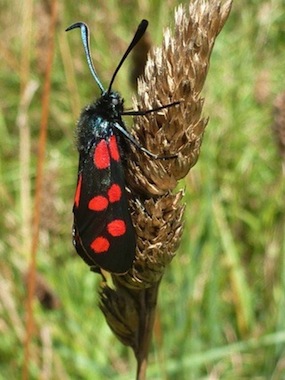 This day-flying moth is a common sight in mid- to late summer, with its flashes of red colour amongst the knapweed and thistles.
This day-flying moth is a common sight in mid- to late summer, with its flashes of red colour amongst the knapweed and thistles.
Photo: Steve Townsend
Scientific name: Zygaena filipendulae
Cornish name: ‘Gouwan’ is the general word for moth
 This brightly-coloured day-flying moth is a common sight through the months of midsummer. Its slow fluttering flight can be observed in grasslands, sand dunes or open woodland areas on hot sunny days from late June to August, and it is often found nectaring on Knapweed, Scabious or Wild Thyme. As its name suggests, this medium-sized moth has six red spots on each of its forewings: the two outermost and, occasionally, the two middle spots can however be fused together, and this can confuse its identification with other Burnet species, such as the Five-spot Burnet. The background colour of the forewings is a deep metallic green, so dark it is almost black, while the hindwings are a black-fringed red.
This brightly-coloured day-flying moth is a common sight through the months of midsummer. Its slow fluttering flight can be observed in grasslands, sand dunes or open woodland areas on hot sunny days from late June to August, and it is often found nectaring on Knapweed, Scabious or Wild Thyme. As its name suggests, this medium-sized moth has six red spots on each of its forewings: the two outermost and, occasionally, the two middle spots can however be fused together, and this can confuse its identification with other Burnet species, such as the Five-spot Burnet. The background colour of the forewings is a deep metallic green, so dark it is almost black, while the hindwings are a black-fringed red.
The Six-spot Burnet has a wide distribution in Europe, including Britain, although in Scotland it is mainly coastal. The larval foodplant is Common Bird’s-foot Trefoil, and sometimes Greater Bird’s-foot Trefoil. The larvae, which are a pale yellow-green with black markings, hibernate through the winter (or occasionally two winters). They emerge to feed in the spring and then pupate by June, usually attaching their papery cocoon to grass or a plant stem, before finally emerging as adults.
Did you know…?
…Very rarely a form of Six-spot Burnet occurs in which the red colouring is replaced by yellow.
…Six-spot Burnets are brightly coloured for a reason: this warns predators they are poisonous to eat. The poison is in fact hydrogen cyanide, which they obtain by feeding on the Bird’s-foot Trefoil as caterpillars.
More information and references:
Waring, P., Townsend, M. and Lewington, R., 2009. Field Guide to the Moths of Great Britain and Ireland (second edition). British Wildlife Publishing, Gillingham, Dorset.
Published: August 2013
Author: Amanda Scott
Photos: Steve Townsend
